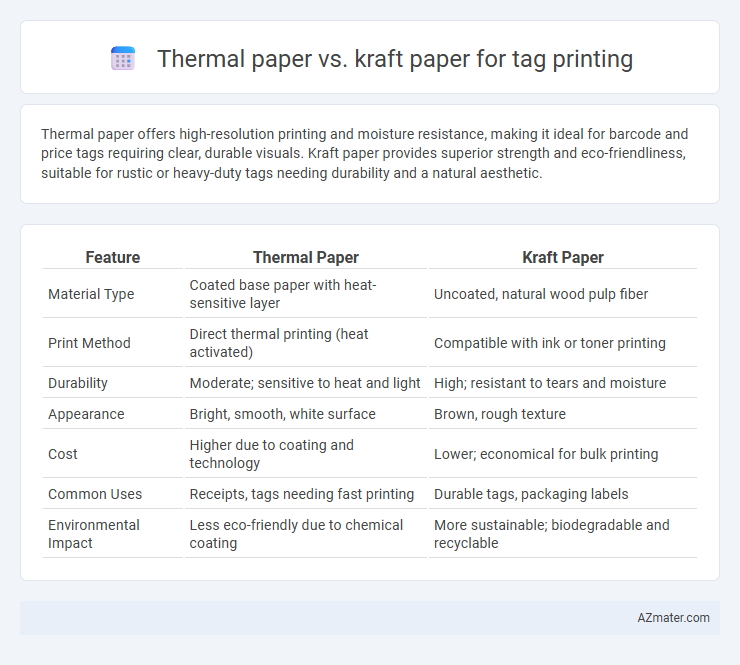Thermal paper offers high-resolution printing and moisture resistance, making it ideal for barcode and price tags requiring clear, durable visuals. Kraft paper provides superior strength and eco-friendliness, suitable for rustic or heavy-duty tags needing durability and a natural aesthetic.
Table of Comparison
| Feature | Thermal Paper | Kraft Paper |
|---|---|---|
| Material Type | Coated base paper with heat-sensitive layer | Uncoated, natural wood pulp fiber |
| Print Method | Direct thermal printing (heat activated) | Compatible with ink or toner printing |
| Durability | Moderate; sensitive to heat and light | High; resistant to tears and moisture |
| Appearance | Bright, smooth, white surface | Brown, rough texture |
| Cost | Higher due to coating and technology | Lower; economical for bulk printing |
| Common Uses | Receipts, tags needing fast printing | Durable tags, packaging labels |
| Environmental Impact | Less eco-friendly due to chemical coating | More sustainable; biodegradable and recyclable |
Introduction to Tag Printing Materials
Thermal paper is a heat-sensitive material widely used in tag printing for its ability to produce fast, high-contrast images without ink or ribbons, making it ideal for short-term labels and receipts. Kraft paper offers durability and a natural, rustic appearance, favored in environments requiring strength and resistance to tearing, often used for product tags and packaging labels. Choosing between thermal and kraft paper depends on the need for print longevity, environmental conditions, and the desired aesthetic of the final tag product.
Overview of Thermal Paper
Thermal paper is a heat-sensitive material commonly used in tag printing for its speed and efficiency, eliminating the need for ink or ribbons. It offers high-quality, clear, and durable prints that are ideal for barcode labels, pricing tags, and receipts in retail and logistics. Thermal paper's smooth surface ensures precise image transfer, making it a preferred choice for applications requiring rapid and cost-effective printing solutions.
Overview of Kraft Paper
Kraft paper, known for its high tear resistance and durability, is widely used in tag printing where robustness and longevity are essential. Its natural brown color and coarse texture provide a rustic, eco-friendly appearance that appeals to environmentally conscious brands. Compared to thermal paper, Kraft paper is ideal for tags exposed to rough handling or external elements, ensuring printed information remains intact over time.
Print Quality Comparison
Thermal paper delivers sharp, high-resolution prints with clear, precise images ideal for barcode and tag printing, ensuring excellent readability and durability under normal handling conditions. Kraft paper, known for its coarse texture and natural fiber composition, produces a more rustic print appearance with less detail sharpness and may result in lower print contrast. Thermal printing consistently outperforms Kraft paper in print quality, especially for detailed graphics and text on tags requiring long-lasting legibility.
Durability and Longevity
Thermal paper offers high print clarity but is more susceptible to fading and damage from heat, moisture, and UV exposure, limiting its durability and longevity for tag printing. Kraft paper, known for its robust fiber structure and resistance to tearing, provides superior durability and longevity, making it ideal for heavy-duty tagging applications in harsh environments. Choosing between thermal and Kraft paper depends on the specific requirements for print longevity and exposure conditions in the tag's intended use.
Environmental Impact
Thermal paper for tag printing often contains chemical coatings and BPA, posing environmental hazards and complicating recycling processes. Kraft paper is biodegradable, recyclable, and produced from sustainable wood sources, making it a more eco-friendly choice for tags. Choosing Kraft paper reduces chemical waste and supports sustainable forestry practices, minimizing environmental impact.
Cost Analysis
Thermal paper for tag printing generally offers lower upfront costs due to its compatibility with direct thermal printers, eliminating the need for ink or ribbons and reducing consumable expenses. Kraft paper, while typically more affordable per sheet, requires ink-based printing methods that increase ongoing costs through toner or ink cartridges. Over time, thermal paper can present a more cost-effective solution for high-volume tagging due to faster printing speeds and reduced maintenance, despite being less durable than kraft paper.
Suitability for Different Applications
Thermal paper excels in high-speed tag printing environments such as retail and logistics due to its smooth surface and ability to produce sharp, precise images without ink, making it ideal for barcode labels and price tags. Kraft paper offers superior durability and strength, suitable for heavy-duty applications like industrial tagging, shipping labels, and product identification where resistance to moisture, tearing, and rough handling is essential. Choosing between thermal and kraft paper depends on specific application needs including print quality, environmental exposure, and longevity requirements.
Customization and Aesthetics
Thermal paper offers high-quality, sharp text and images ideal for detailed logos and barcodes, making it perfect for customizable tags requiring precision and durability. Kraft paper provides a rustic, natural aesthetic with a textured surface that enhances the visual appeal of eco-friendly brands, allowing for unique printing techniques like letterpress or embossing. Customization on thermal paper excels in clarity and quick printing, while Kraft paper delivers a distinctive, tactile experience that aligns with artisanal or vintage branding.
Choosing the Right Paper for Your Tags
Thermal paper offers high-resolution printing with smooth surfaces ideal for barcode and price tag applications, while Kraft paper provides superior durability and a natural, rustic appearance suitable for eco-friendly and heavy-duty tags. Selecting the right paper depends on the tag's purpose, environment, and longevity requirements; thermal paper excels in short-term use and indoor environments, whereas Kraft paper withstands rough handling and outdoor exposure. Consider factors such as print quality, cost-effectiveness, and environmental impact to ensure optimal tag presentation and performance.

Infographic: Thermal paper vs Kraft paper for Tag printing
 azmater.com
azmater.com